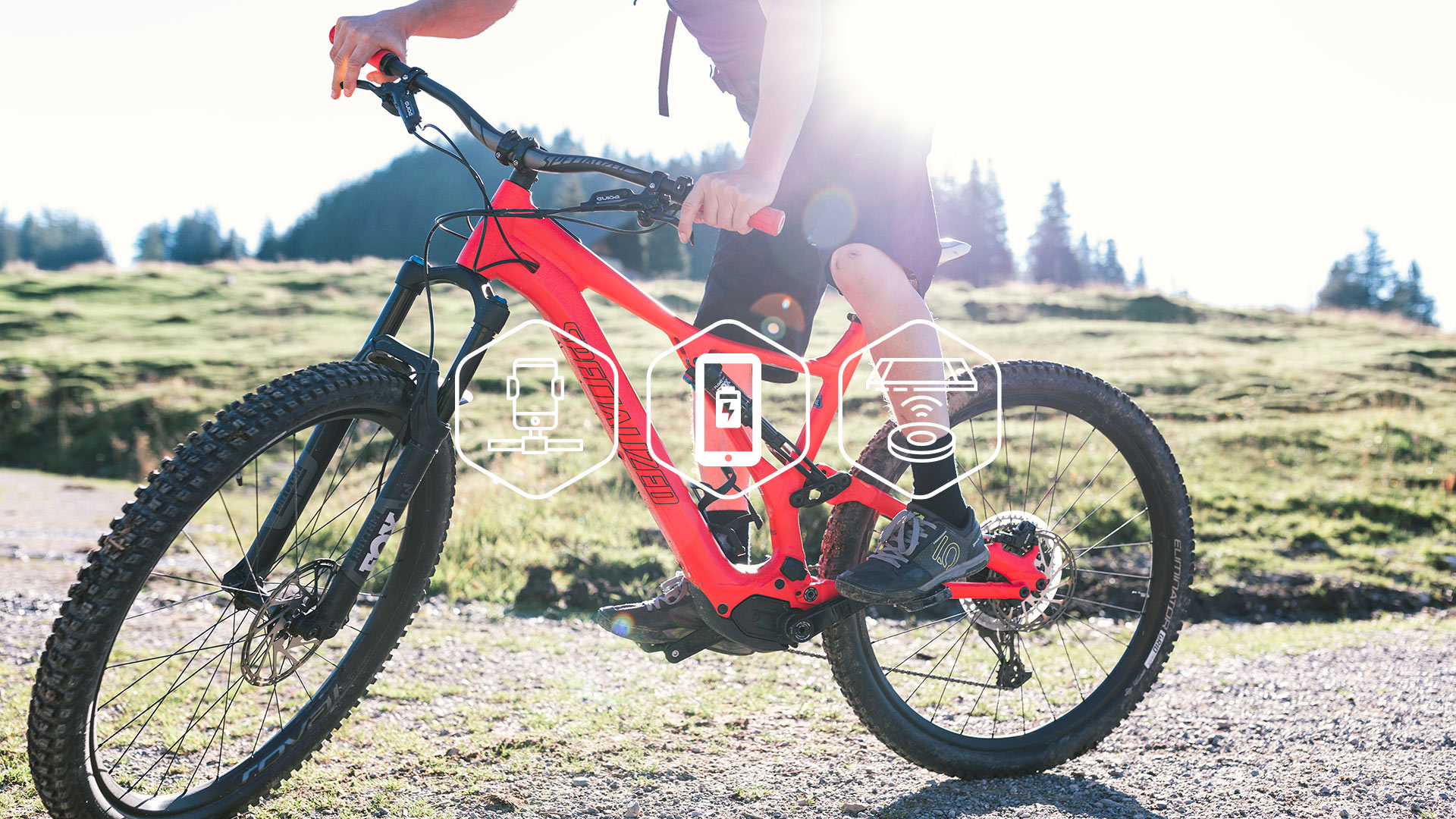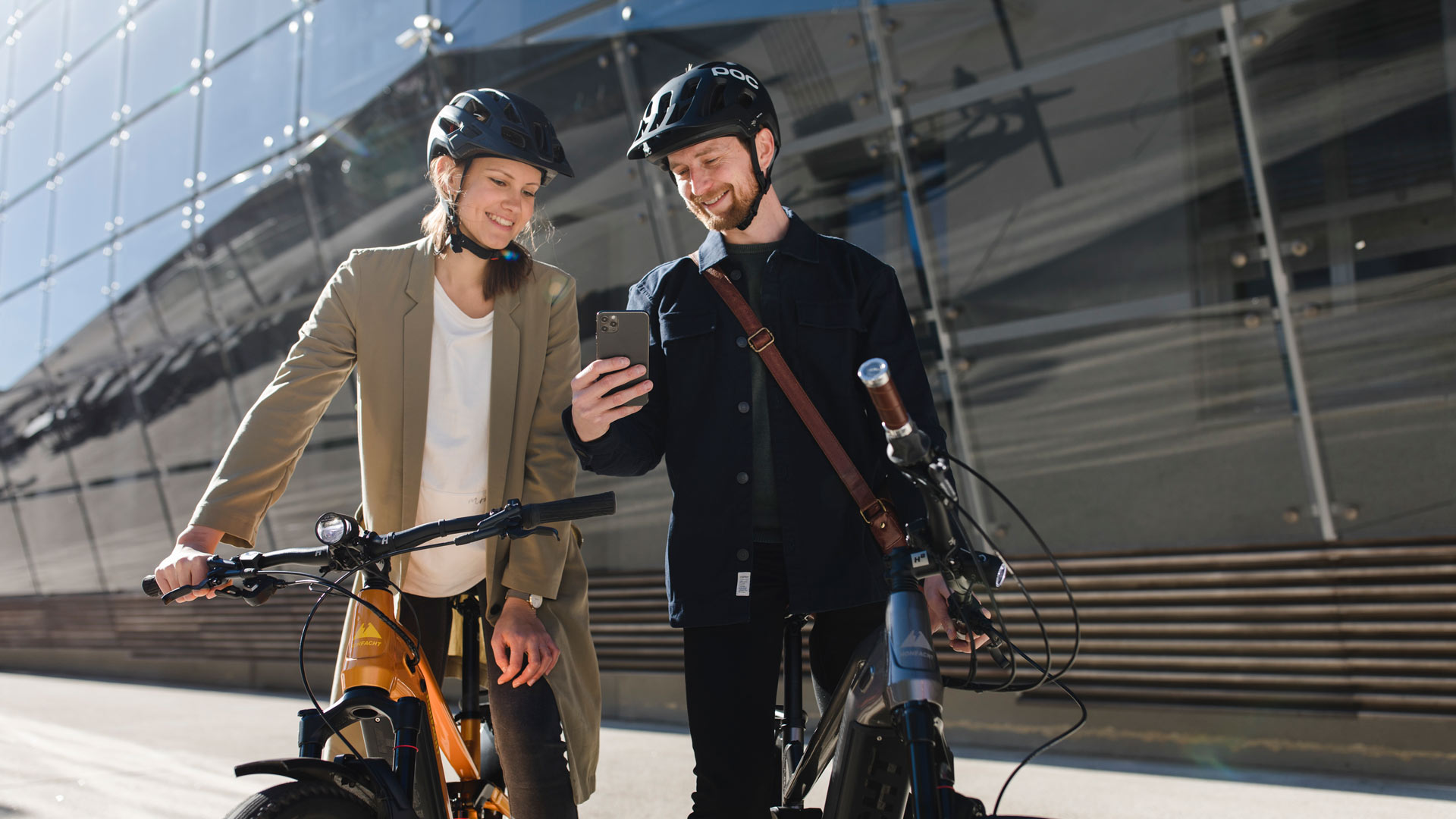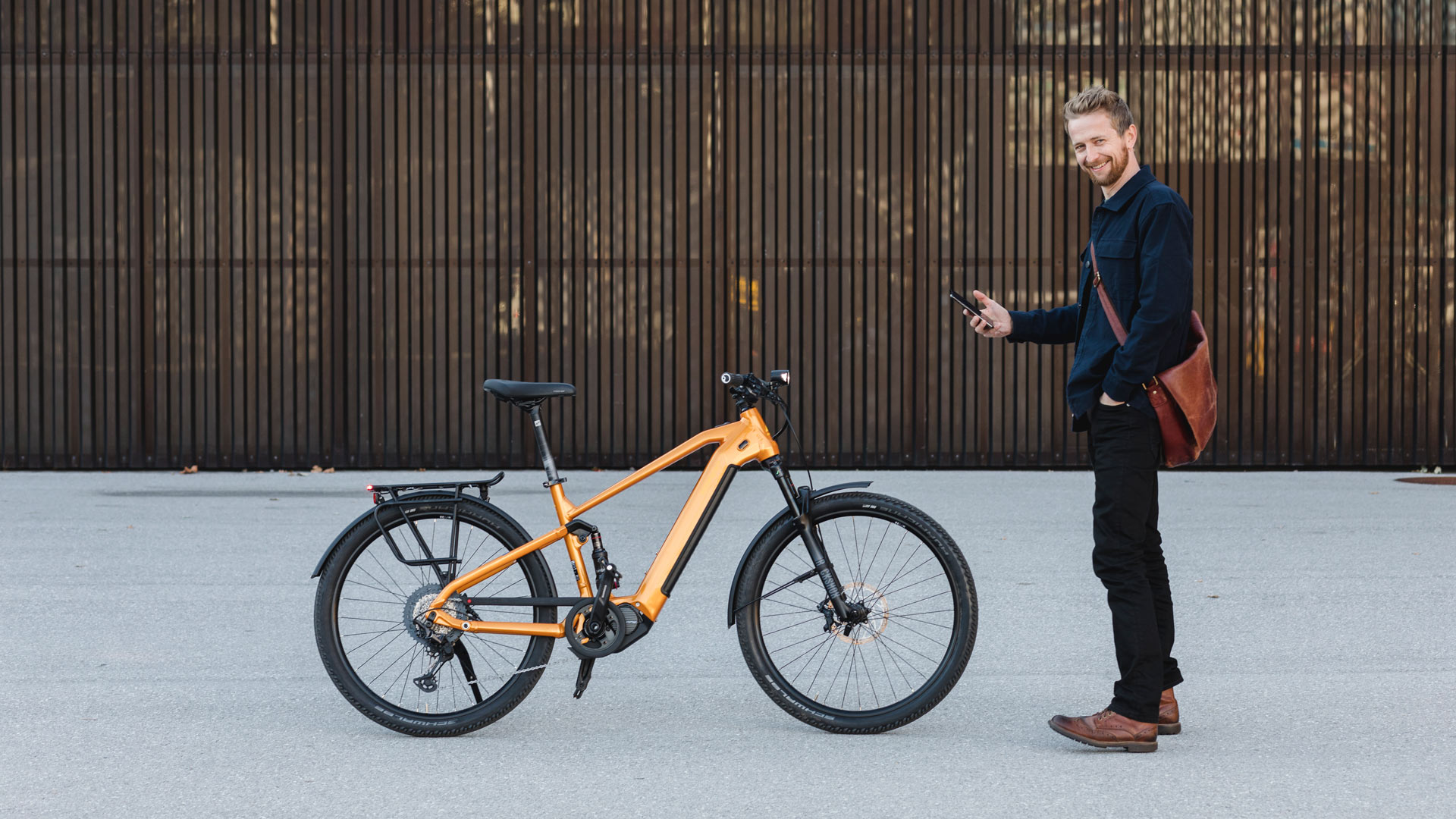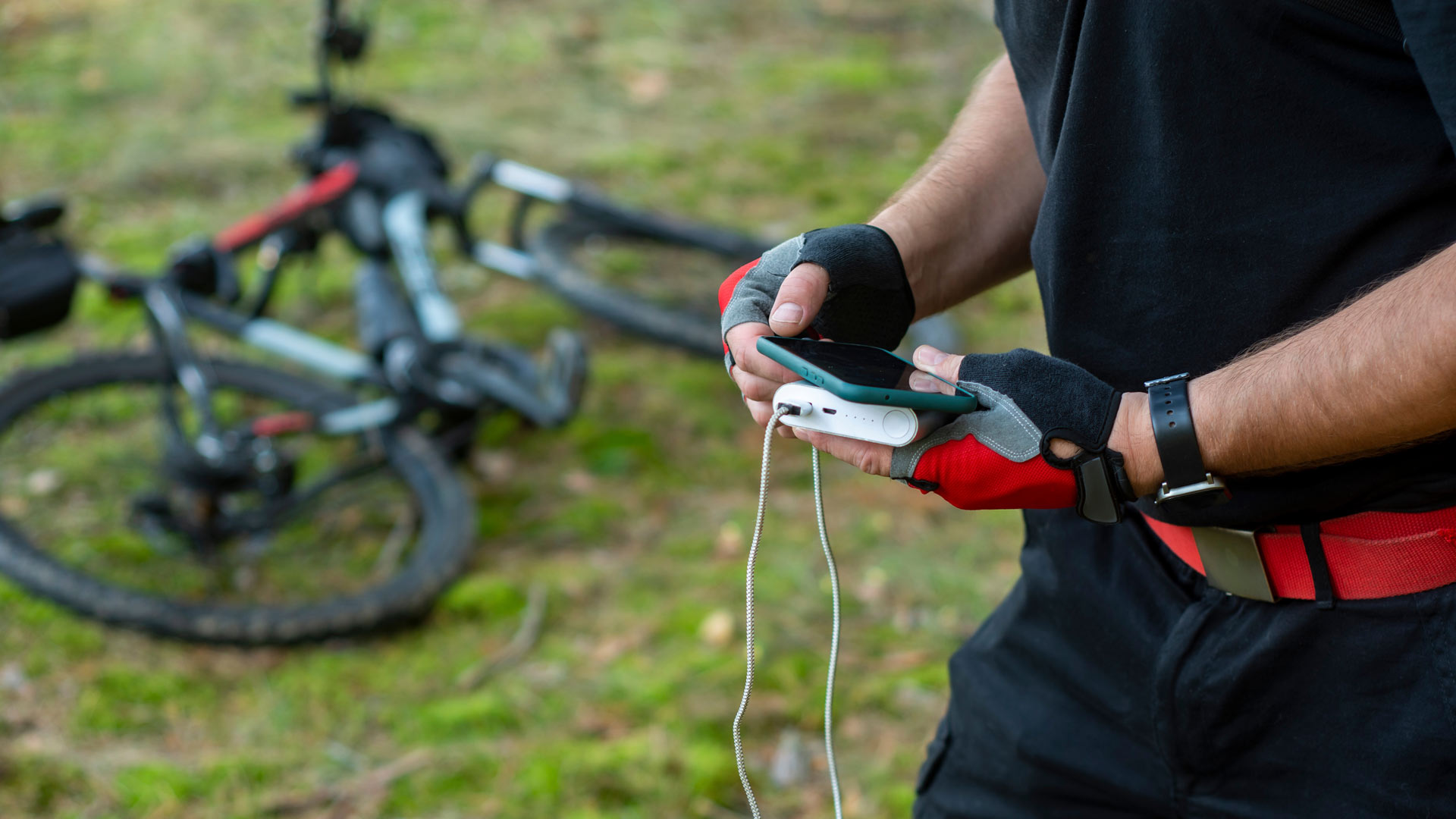- Free shipping from 220€The order of accessories (without BikeTrax) is excluded from the free shipping costs.
PowUnity explains, Top, Topics
E-bike phone charger: keeping your smartphone functional during a bike tour
Inhalt
Charging a cell phone on an e-bike in a nutshell
- Whether you can charge your smartphone directly on your e-bike depends on the display. Depending on the manufacturer and model, this has a connection that is also suitable for powering cell phones.
- Even if there is a port, however, the amount of current is often only enough to prevent the cell phone from discharging. Exceptions are the SP Connect Wireless Charging Module and Cobi.Bike from Bosch.
- Powerbanks are an inexpensive and practical alternative for charging cell phones on the go.
In our overview article “How to find the best e-bike app for your needs”, we looked at the potential of mobile phone apps for e-bike riding. Whether GPS navigation, fitness tracking aimed at health benefits, or managing settings on the bike – with the right apps, a smartphone can replace a bike computer.
Although it is very practical, there is one catch: every mobile phone needs energy. And the more active it is, the more energy it needs. When using it for navigation on a longer ride, its high energy usage can become a challenge. And sometimes this even applies to a short ride in case your battery is not fully charged.
Running out of phone battery does not have to be such a big deal – after all, your e-bike also has a battery. However, it’s not quite that simple.
Using the electric bike battery for the mobile phone – when it is possible and when not
All e-bikes, regardless of whether they are e-MTBs or e-city bikes, have batteries and thus electricity on board. But tapping into this power source is not always so easy for your cell phone.
The decisive factor is not the e-bike itself, but the display. Depending on the manufacturer, it has a USB or micro-USB port. This is primarily intended for service, but sometimes it is also suitable for powering a cell phone.
Unfortunately, the amount of power you can draw this way is rather limited. Often it is only enough to slow down the discharge of the cell phone during its use, while some cell phones do not respond to it at all. And there are also cases where there is no charging option at all.
Overview of displays for electric bikes from different manufacturers
With or without a charging option, with a USB port on the display or as a smartphone hub with an app, modern displays for electric bikes vary greatly. In the following section, we will take a closer look at some devices from popular brands.
Bosch
E-bike displays from Bosch impress with high performance and innovative features. However, they offer only limited support for charging mobile phones. All Bosch displays have a Micro USB port type A that can be connected to various smartphones with the appropriate charging cable. The most common connection cables (USB-C connector for Android smartphones or lightning connector for iOS devices) are available for sale.
Bosch Intuvia
The Bosch Intuvia is rightly an evergreen among displays. However, the USB port only supplies 0.5 amps to your cell phone.
Bosch Nyon
The Bosch Nyon of the first generation also only provides 0.5 amps for your mobile phone. And the second generation doesn’t even have a charging option. The Micro USB port type A can only be used for maintenance purposes.
Bosch Purion Display
The Purion display also has no charging option.
Bosch Kiox
With a Bosch Kiox you can enjoy 1 ampere for your mobile phone. Still not much, but better than nothing.
Cobi.Bike
For some time now, Bosch has been offering a smartphone hub for e-bikes called Cobi.Bike. This practical device including an app turns your mobile phone into a command centre for cycling and even has an integrated charging device. It’s ideal if you want to do without a conventional display, but it’s rather expensive.
Yamaha
Yamaha drives are used in Haibike e-bikes, for example. In this case, too, it depends on the display whether you can use the battery as a power source for your smartphone:
According to the manufacturer, both the Yamaha C and the Yamaha X offer up to 1 ampere to charge your smartphone or at least to delay discharging.
With the Yamaha A, you have to do without this option.
Flyer
Some Flyer e-bikes are equipped with a Panasonic drive. The associated FIT display scores with a classic USB port that supplies your smartphone with a little more than 1 ampere.
Brose
Like many manufacturers of drives, Brose has revised its displays in recent years or taken their production into its own hands.
However, this has not brought good news for charging smartphones from the electric bike battery – because the new models generally only have a suitable connection for e bike chargers.
SP Connect Wireless Charging Module
The SP Connect Wireless Charging Module is not a display, but a mobile phone holder for inductive charging of your smartphone. Simply mounted on the handlebar, it charges your phone. To couple the device with the battery of your electric bike, you also need the SP Wireless Charger cable.
Summary: Manufacturers usually offer only limited charging options
The brands mentioned here are only a few among many, but they reveal a fundamental dilemma that also applies to other manufacturers, such as Giant: many displays do not have a connection to charge your smartphone. Even if the option is available, the amount of power supply is very limited.
If you use your smartphone as a bike computer anyway and don’t need a display – the SP Connect Wireless Charging Module is the best solution. And with Cobi.Bike from Bosch you are also on the safe side. Although you have to pay more, you get a complete system including an app.
Tip: If you have the option to connect your mobile phone to the display, you will need the appropriate USB ports, such as Micro USB-A to USB-C or a Lightning connector for Apple devices.
Note: No matter which app you use on the road, you need a holder for your smartphone. Find out why just any mount is not the solution and what makes a good mount in our article “E-bike phone holder: e-bike, road and smartphone at a glance”.
Drawing power from the dynamo
Many cyclists swear by a dynamo for their bicycle lights. After all, they don’t have to worry about the battery going flat and the light going out in the dark in the forest. In addition, modern hub dynamos are durable and not affected by the weather.
If you have a bicycle with a dynamo, you can use it to charge your mobile phone. However, you need an adapter that converts alternating current into direct current and regulates the voltage.
E-bike riders hardly benefit from this as modern lighting systems for pedelecs draw their power from the bike battery.
The classic: portable charger, aka power bank
There is another way to charge your mobile phone when you are on an e-bike ride: you take a power bank with you.
The advantages of this option:
- Portable chargers (i.e. lithium ion batteries) are relatively cheap.
- They take up little space and can easily be carried in a bag.
- They are available in more robust versions for outdoor use.
- Depending on the model, you can charge your mobile phone several times with one battery pack.
Sounds good? Well, then it’s important to choose the right power bank.
You should pay particular attention to the following criteria:
- Capacity: 5,000 mA or less is usually only enough for one charge. For longer trips and/or multiple devices, we recommend three or four times that.
- Weight: Unfortunately, battery packs with more capacity are heavier. If every gram counts, we recommend a compromise between high performance and low weight.
- Charging time: How long does the charging take? Short charging times save you some precious time on your tour.
- Connections: Maybe you want to charge several devices at the same time on one power bank. In that case, one USB port is not enough. The type of connections can also play a role.
- Robustness: If you prefer to go on tours with your e-MTB in windy or rainy weather, the power bank should be robust. If in doubt, a waterproof model is worthwhile.
Solar charger: charging with the power of the sun
Environmentally friendly, practical, inexpensive: solar chargers for smartphones are the ideal alternative to electricity from the grid or from the e-bike battery. Depending on the model, you can strap them onto the luggage rack. Solar chargers with integrated lithium ion batteries help you to get through rainy days. This is important, because for all their advantages, solar chargers have one major disadvantage: they only work when the sun is shining.
For the most part, the same rules to the selection apply as to conventional power banks. Powerful solar chargers are not only suitable for mobile phones, but also for tablets and the like.
Conclusion: The simplest solution is sometimes the best one
It could be so simple: connecting your smartphone to the e-bike battery (like the electric bike charger), done. But in reality, things are more complicated.
Many modern displays of popular brands provide very little or no power for your mobile phone. Since e-bikes, unless they are converted from conventional bikes, do not have a dynamo, this option also falls flat.
This leaves you with two main options if you want to charge your mobile phone while cycling:
- You can use a holder with charging function or a smartphone hub, such as Bosch offers with Cobi.Bike.
- You can take a power bank with you.
If you only want one “charging solution”, a power bank offers good value for money.
Share article!






 Deutsch
Deutsch